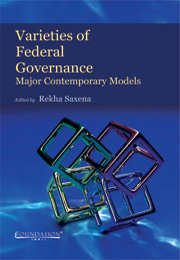Book contents
- Frontmatter
- Contents
- List of Contributors
- Foreword
- Acknowledgements
- Introduction
- I Theoretical and Comparative Dimensions
- II Presidential Federal Systems
- III Commonwealth Parliamentary Federations
- IV Non-Commonwealth Parliamentary Federations in Afro-Asia
- V European Parliamentary Federations
- VI Devolutionary Systems
- VII Supranational Confederalism/Federalism?
20 - The European Union and the Competence Catalogue after the Lisbon Treaty: Insights from Comparative Federalism
from VII - Supranational Confederalism/Federalism?
Published online by Cambridge University Press: 05 June 2012
- Frontmatter
- Contents
- List of Contributors
- Foreword
- Acknowledgements
- Introduction
- I Theoretical and Comparative Dimensions
- II Presidential Federal Systems
- III Commonwealth Parliamentary Federations
- IV Non-Commonwealth Parliamentary Federations in Afro-Asia
- V European Parliamentary Federations
- VI Devolutionary Systems
- VII Supranational Confederalism/Federalism?
Summary
Introduction
The EU is in search of improving its democracy and legitimacy record. Referendums in Denmark and France on the Maastricht Treaty, and in Ireland on the Nice Treaty, revealed the limits of the permissive consensus underpinning the process of European integration. Since then, support for the European Union suffered further setbacks as illustrated by the rejection of the European Constitutional Treaty by a majority of French and Dutch voters in the Spring of 2005 and the surprising Irish no-vote against the Lisbon Treaty in the Spring of 2008.
Constitutional reform has been on the agenda of the EU for more than a decade. The Maastricht Treaty (Treaty on European Union or TEU), signed in 1992 meant a major breakthrough in the political and economic integration of Europe, as it propelled the birth of the single currency (Euro) and developed the notion of a ‘three-pillar structure’ with the Common and Foreign Security Policy (CFSP) and Justice and Home Affairs (JHA) as two new ‘intergovernmental’ pillars of European co-operation, alongside the ‘supranational’ pillar covering economic and monetary integration. The Amsterdam Treaty (1998) extended this process, by strengthening the notion of a European citizenship and increasing the powers of the European Parliament. The Nice Treaty (2001) was meant to prepare the EU for its significant Eastward enlargement by adapting its institutional structure, initially developed for only six member-states, to suit the needs of no less than twenty-seven member-states.
- Type
- Chapter
- Information
- Varieties of Federal GovernanceMajor Contemporary Models, pp. 467 - 493Publisher: Foundation BooksPrint publication year: 2011



